 home // store // text
files
// multimedia // discography // a
to zed
// random
// links
home // store // text
files
// multimedia // discography // a
to zed
// random
// links
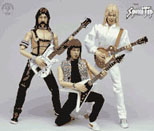 Mat Falls, who sculpted the 12-inch Spinal
Tap dolls for Sideshow Toys, agreed to answer a few questions
about the delicate challenge of recreating the craniums of one
of England's loudest bands. Mat Falls, who sculpted the 12-inch Spinal
Tap dolls for Sideshow Toys, agreed to answer a few questions
about the delicate challenge of recreating the craniums of one
of England's loudest bands.
How did you arrive at what must be the peak of your career
as a dollmaker?
I began my career working in makeup effects for movies and
television in Hollywood, but the way the industry was heading
with CGI and digital effects I thought it would be best to look
for another source of income. Now I'm one of the four partners
in Sideshow Toys, and I sculpt all of our dolls.
Did you want to be a sculptor as a kid?
I grew up in Stockton, California, which is familiar to Tap fans
as the site of the Themeland Amusement Park. I was really into
horror films because of the makeup and costumes. I still love
all the classics: Frankenstein, the Creature From the Black Lagoon,
the Phantom of the Opera.
How did you land the Spinal Tap deal?
Sideshow's designer, Ken Morgan, and I are fans of the film.
We were thinking about dolls we'd love to do, and Spinal Tap
came up. We approached the band about creating action figures,
and they loved the idea.
Tell me about the process of making the heads of each doll.
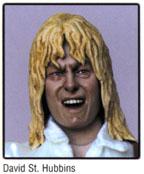 Ken and I met with the band and took
photos of their heads. It was a kick to meet them, although I
tried to remain professional. I had each of them pose expressionless,
then slowly turn around so I could take four to six shots around
their heads. Using the photos as a model, I sculpted each head
in wax at one-sixth scale, or the same size they appear on the
dolls. To do this, I shrank myself down so my head was also an
inch-and-a-half inch high. Actually, I use a custom tool that
resembles a looped piece of wire. It's a process of adding wax
and taking it away. You block out the general features and then
hone in for the finer features such as eyelids and nostrils. Ken and I met with the band and took
photos of their heads. It was a kick to meet them, although I
tried to remain professional. I had each of them pose expressionless,
then slowly turn around so I could take four to six shots around
their heads. Using the photos as a model, I sculpted each head
in wax at one-sixth scale, or the same size they appear on the
dolls. To do this, I shrank myself down so my head was also an
inch-and-a-half inch high. Actually, I use a custom tool that
resembles a looped piece of wire. It's a process of adding wax
and taking it away. You block out the general features and then
hone in for the finer features such as eyelids and nostrils.
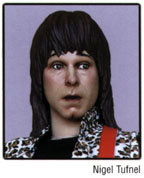  Once
the band was satisfied with the look of the sculpted heads, we
made a soft rubber mold and from that a copy out of resin. The
hair is sculpted in soft rubber and attached. We considered doing
the hair with synthetic strands, such as you'd see on a Barbie,
but the band's haircuts are stylized and we thought rooted hair
might look too generic. Once
the band was satisfied with the look of the sculpted heads, we
made a soft rubber mold and from that a copy out of resin. The
hair is sculpted in soft rubber and attached. We considered doing
the hair with synthetic strands, such as you'd see on a Barbie,
but the band's haircuts are stylized and we thought rooted hair
might look too generic.
How about the rest of the body and the costumes?
We use standard 12-inch poseable male doll figures. The challenge
of the fabric costumes was finding leopard skin fabric in the
right scale for Nigel's vest. The spots had to 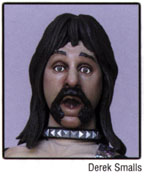 be one-sixth
scale to look right. With Derek we had to find convincing artificial
leather that was moveable. There were no real problems with David;
he's in white. be one-sixth
scale to look right. With Derek we had to find convincing artificial
leather that was moveable. There were no real problems with David;
he's in white.
We also created specialized hands, positioned as they might be
when strumming a guitar. We could have saved some money by just
using stock hands but that wouldn't have looked realistic.
Who else is involved in making the dolls?
Tom Gilliland painted each doll and saw through the costume
design. Robin Ferguson did the package design and Ken Morgan
did the doll design. He works in 2-D and then I put it into 3-D.
Sideshow has 15 to 20 employees in the office each day, depending
on their moods.
How are the dolls selling? Do people order one doll more
than others?
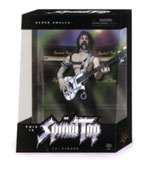 We
started taking orders in October and virtually everyone has ordered
all three dolls, which is smart. You can't have one without the
others, and because there's a limited supply, people may not
be able to get the other two later on. The plan is to have a
second set of Tap dolls ready by February. I'll sculpt them from
different portraits, and we'll give them new outfits. They'll
also be able to speak their signature lines. [Sadly, these second
set of dolls never came to be. But here's an
exclusive look at what they were supposed to look like. Elsewhere,
Cosmic Shambles has posed the dolls in some delectable
positions.—Ed.] We
started taking orders in October and virtually everyone has ordered
all three dolls, which is smart. You can't have one without the
others, and because there's a limited supply, people may not
be able to get the other two later on. The plan is to have a
second set of Tap dolls ready by February. I'll sculpt them from
different portraits, and we'll give them new outfits. They'll
also be able to speak their signature lines. [Sadly, these second
set of dolls never came to be. But here's an
exclusive look at what they were supposed to look like. Elsewhere,
Cosmic Shambles has posed the dolls in some delectable
positions.—Ed.]
|